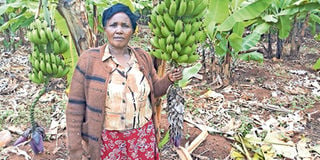Villager finds comfort in growing tissue culture bananas

Lucy Muriithi in her banana farm in Kirinyaga County. She acknowledges that tissue culture bananas take a shorter time to mature. PHOTO | SAMMY WAWERU | NMG
What you need to know:
- Mrs Muriithi grows tissue culture bananas.
- Seedlings are propagated in a special laboratory under sterile conditions for weeks.
- Tissue culture bananas are as a result of technology.
- To address the problem of brokers middlemen, Mr Macharia and other experts advise local farmers to add value to their bananas.
Karii in Kirinyaga is a farming village. Upon upon arrival, one is greeted with tomatoes, vegetables and fruits. The area is also popularly known for bean farming while others grow maize on a small scale.
On Mrs Lucy Muriithi’s one-acre piece is a canopy of bananas. Some are fruiting and others flowering. She checks on a swaying bunch to see it it is ready for harvest.
“I’ll harvest several bunches in a few weeks,” she says. Ms Muriithi used to grow French beans but it was a venture that was not profitable.
“Getting a market for French beans is not easy. Most of it ended up rotting on the farm,” she says. Compared to French beans, producing bananas is economical, she says. After rice, wheat and maize, banana is the most consumed food worldwide.
Mrs Muriithi grows tissue culture bananas. “I started with half an acre with a Sh25,000 capital five years ago,” she says.
Seedlings are propagated in a special laboratory under sterile conditions for weeks. They are later hardened in a greenhouse before being transferred to the field.
The use of suckers is still the preferred banana farming method for many locals. Farmers says it uses few inputs.
PRONE TO PESTS AND DISEASES
Unfortunately, such plants are prone to pests and diseases like Sigatoka, banana streak, bacterial and fusarium wilt.
Banana weevils and nematodes are common in plants from suckers. The traditional bananas also take long to mature and the yields are little.
Tissue culture bananas are as a result of technology. The technique, also known as micro - propagation, allows multiplication of uniform and quality clones. The plantlets are healthy and free from viruses.
Mrs Muriithi says tissue culture bananas take short time to mature. “They are ready for harvesting in less than a year,” she says.
To produce the bananas, ensure the land is well drained. Pits should be 3x3x3ft and spacing shoud be 10x10ft she says.
Fertiliser, well decomposed manure and suggested nematicide should be mixed and the holes stuffed with the mixer to a height of a foot.
“The remaining space is for mulching and nurturing the plants,” she says, adding that she gets water from River Thiba.
Experts say for quality and maximum produce, suckers around the mother plant should be pulled out.
“Too many compete for water and nutrients with the mother,” advises Mr James Macharia.
For the first harvest, a plant produces a bunch, from the second year onwards, three to four bunches, each weighing 25-30kgs.
To address the problem of brokers middlemen, Mr Macharia and other experts advise local farmers to add value to their bananas.





